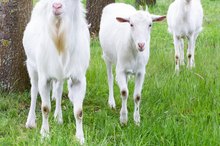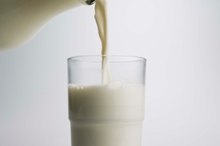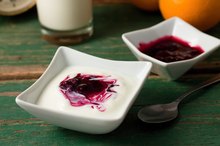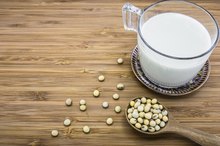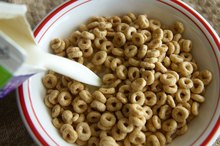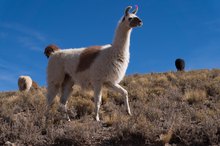What does fact checked mean?
At Healthfully, we strive to deliver objective content that is accurate and up-to-date. Our team periodically reviews articles in order to ensure content quality. The sources cited below consist of evidence from peer-reviewed journals, prominent medical organizations, academic associations, and government data.
The information contained on this site is for informational purposes only, and should not be used as a substitute for the advice of a professional health care provider. Please check with the appropriate physician regarding health questions and concerns. Although we strive to deliver accurate and up-to-date information, no guarantee to that effect is made.
The Dangers of Pasteurized Homogenized Milk
The milk pasteurization debate rages on in America, although many people remain unaware of the growing ranks of raw milk converts 2. Raw milk aficionados, who often have to buy their milk clandestinely, since only half the states in the United States allow the sale of raw milk, according to United Press International, believe that raw milk has numerous health benefits over the pasteurized version. In fact, proponents go as far as to say that pasteurized milk is dangerous to drink. The U.S. Food and Drug Administration denies these claims 1.
Pasteurization Facts
Pasteurization does not heat milk to the same temperature as sterilization does. Pasteurization does not cause as much nutrient loss as sterilization because of lower temperatures used. Pasteurization does result in the loss of around 10 of vitamin B-1 and 20 percent of vitamin C in milk, the Encyclopedia of Science explains 2. After pasteurization milk goes into sterilized bottles to prevent contamination. Homogenized means that the large fat globules are broken up to keep the cream from separating from the rest of the milk. Raw milk, on the other hand, is not processed in any way -- you drink it just as it comes from the cow.
- Pasteurization does not heat milk to the same temperature as sterilization does.
- Homogenized means that the large fat globules are broken up to keep the cream from separating from the rest of the milk.
Critics Claims
Raw Goat's Milk for Weight Loss
Learn More
Critics of pasteurized milk assert that it has sickened more people due to bacteria that gets into the milk far more often than people have gotten sick from raw milk. Since many more people in the United States drink pasteurized milk than raw, this is probably true. However, if the numbers were equal, no one knows which would cause more infections. Critics of pasteurization also claim that it causes more allergies, because it removes "good" bacteria along with bad and increases the risk of lactose intolerance and milk allergies 2.
- Critics of pasteurized milk assert that it has sickened more people due to bacteria that gets into the milk far more often than people have gotten sick from raw milk.
Real Concerns
Salmonella outbreaks have been traced to pasteurized milk. In one case reported by the Centers for Disease Control and Prevention, pasteurized milk was contaminated with salmonella bacteria at some point after pasteurization. Inadequate pasteurization does not seem to be the main problem in infection outbreaks; rather contamination due to environmental condition in the milk processing plant and contamination by employees seem to be more serious issues.
Considerations
What Is the Difference Between Vitamin D Milk & 1% Milk?
Learn More
If you're pregnant, drinking unpasteurized raw milk that contains the bacteria Listeria monocytogenes could cause illness that affects you and the fetus. Pasteurization kills the bacteria 2. Pregnant women contract listeria 20 times more often than healthy non-pregnant adults, according to the American Pregnancy Association. In 22 percent of cases, the fetus dies. Avoid raw milk and unpasteurized cheeses if you're pregnant, even if you have concerns about pasteurization. The elderly, the immunocompromised and the very young should also avoid raw milk.
- If you're pregnant, drinking unpasteurized raw milk that contains the bacteria Listeria monocytogenes could cause illness that affects you and the fetus.
- The elderly, the immunocompromised and the very young should also avoid raw milk.
Related Articles
References
- U.S. Food and Drug Administration: June 2011
- The Encyclopedia of Science: Pasteurization
- UPI.com; Raw vs. Pasteurized Milk a Hot Debate; Chuck Debevec; July 2010
- RealMilk.com; Fresh, Unprocessed (Raw) Whole Milk: Safety, Health and Economic Issues ; 2009
- Consumption of raw or unpasteurized milk and milk products by pregnant women and children. Pediatrics. 2014;133(1):175-9. doi:10.1542/peds.2013-3502
- Macdonald LE, Brett J, Kelton D, Majowicz SE, Snedeker K, Sargeant JM. A systematic review and meta-analysis of the effects of pasteurization on milk vitamins, and evidence for raw milk consumption and other health-related outcomes. J Food Prot. 2011;74(11):1814-32. doi:10.4315/0362-028X.JFP-10-269
- U.S, Food and Drug Administration. The Dangers of Raw Milk: Unpasteurized Milk Can Pose a Serious Health Risk. Updated November 8, 2018.
- U.S. Food and Drug Admininistration. Raw Milk Misconceptions and the Danger of Raw Milk Consumption. Updated September 22, 2018.
Resources
Writer Bio
A registered nurse with more than 25 years of experience in oncology, labor/delivery, neonatal intensive care, infertility and ophthalmology, Sharon Perkins has also coauthored and edited numerous health books for the Wiley "Dummies" series. Perkins also has extensive experience working in home health with medically fragile pediatric patients.
